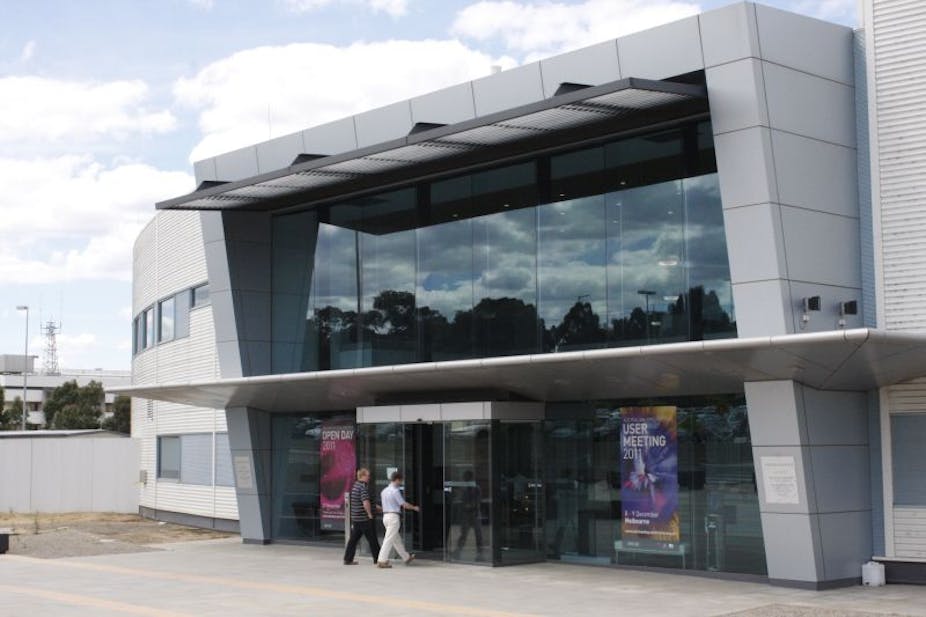Science is like high-performance racing: today’s Formula One machine is all too soon the jalopy of tomorrow. The Australian Synchrotron, opened in 2007 and located in Melbourne, is currently at the F1 end of the spectrum. Needless to say, its 120 staff and thousands of active researchers would like to keep it that way.
Which raises a pertinent and obvious question: what does it actually do?
Technically speaking, a synchrotron is a large machine that accelerates electrons to almost the speed of light. As those electrons are deflected through magnetic fields they create extremely bright light, meaning a synchrotron is also a “light source”. Synchrotron light (X-rays and infrared light) is a million times brighter than the sun.
Compared to conventional sources, such as those that might be encountered while sitting in a dentist’s chair, the X-rays produced at the Synchrotron are like a laser is to a light bulb.

In addition to their high brightness, X-rays are emitted as a beam and can be effectively tuned to a single wavelength (a bit like being able to choose the colour of your laser beam). Along with other, more specialised properties, such as nanosecond-scale pulsed emission, the characteristics of the light means synchrotron-based experiments are typically more accurate, more detailed, more specific and faster than those obtained using conventional laboratory equipment.
To the thousands of researchers who use it each year, the facility is a toolbox of state-of-the-art experimental techniques that enables them to reach their research goals faster and to go beyond what they could otherwise achieve in a conventional laboratory.
The football field-sized facility – with 10 purpose-built individual experimental laboratories – offers access to the nanoscale world by several different paths.
Since the facility opened, more than 4,000 biologists, medical scientists, chemists, materials scientists, forensic scientists, geo-chemists, physicists, engineers, art conservators, environmental scientists and agricultural scientists, among others, have taken advantage of the new approaches available to them.
For most researchers, it’s a place to conduct experiments that simply could not be performed anywhere else in the country.
The need for speed
The brightness of synchrotron X-rays means that determining the three-dimensional structure of an AIDS virus protein – to give just one example – could take a matter of minutes instead of hours, or even days, of data collection and manipulation. This technique relies on making crystals of the target protein that are of a certain quality.
The Synchrotron can rapidly screen many thousands of “candidate” crystals, with usable data collected in hours, rather than months as might be required with conventional approaches.

Many researchers view the Synchrotron as an essential tool for studying or developing new drugs to combat diseases such as various cancers, malaria, rheumatic fever and yellow fever.
Being able to determine highly-detailed three-dimensional structures of target proteins, either by themselves or interacting with potential drug molecules, speeds up the lengthy process of taking a drug from concept stage to the market.
Synchrotron techniques for determining protein structures are also helping researchers find new ways of tackling the malaria parasite, and expanding our knowledge of how the immune system works, which could lead to new treatments for autoimmune diseases such as early onset diabetes or for tissue rejection following bone marrow transplantation.
A giant microscope?
Other researchers see the facility as akin to a giant microscope that uses infrared light or X-rays to map the micro- or even nanoscale distribution of metals in mineral ores, or the location of proteins and fats in animal cells.
But, unlike a conventional light microscope, the Synchrotron can also identify the specific chemical form of the metals or other components under investigation – at each location on the map.
This is crucial information for those seeking to improve mineral prospecting or processing methods, or to understand the very early stage progression of diseases such as multiple sclerosis or Parkinson’s.
Heavyweight (teraflop) computing power means that two-dimensional X-ray maps can also be transformed into three dimensions, much like a CT or CAT scan. The largely non-destructive nature of synchrotron techniques also makes them eminently suitable for examining precious cultural artefacts, artworks and documents, and for forensic investigations – particularly in instances where samples are only available in minute quantities.
Going with the grain
Rice, barley and other cereal grains are important energy sources for many millions of people around the world. Unfortunately, diets that rely too heavily on these relatively poor sources of nutrition are often low in important micronutrients such as iron.
Researchers from the University of South Australia, the Australian Centre for Functional Plant Genomics and the University of Melbourne are using synchrotron mapping techniques to investigate various strategies to improve the levels of iron, zinc and other important micronutrients in these staple food grains. Their findings, it is hoped, will aid the development of better processing methods and breeding programs.


Looking to the future, it’s possible to draw on the experience of other synchrotron facilities around the world and predict that the scale of impact and productivity of the Australian Synchrotron will grow. But this will only occur if two things happen:
1) The current operating capability of the facility is maintained. It was built by the Victorian Government, which invested A$157 million in the project. The Australian and New Zealand governments as well as universities and major research institutions such as ANSTO and CSIRO provided additional financial support worth A$50 million in total.
Currently, the Victorian and Australian Governments contribute equally to the operating costs.
2) The facility continues to operate at the cutting edge of synchrotron technology. The Synchrotron is very productive precisely because it operates at a level that allows the best techniques to be effectively deployed.
It is the ability to operate at this level, combined with the development of new and improved capabilities, that will enable the Australian synchrotron science community to achieve its full potential.
The Synchrotron is a powerhouse of Australian research. Keeping it at or above world standards is not just desirable – it’s essential.

